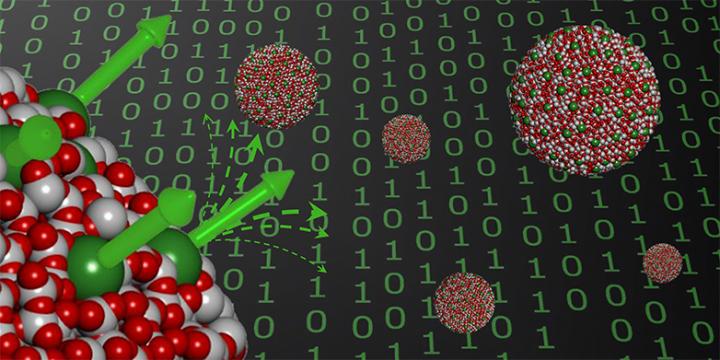Nanomagnets for future data storage

Dysprosium atoms (green) on the surface of nanoparticles can be magnetized in only one of two possible directions: "spin up" or "spin down." Credit: ETH Zurich / Université de Rennes
However, several obstacles still need to be overcome before single-molecule magnet data storage becomes a reality. Finding molecules that can store the magnetic information permanently and not just fleetingly is a challenge, and it is even more difficult to arrange these molecules on a solid surface to build data storage carriers. To address the latter problem, an international team of researchers led by chemists from ETH Zurich has now developed a new method that offers numerous advantages over other approaches.
Fusing atoms to the surface
Christophe Copéret, a professor at the Laboratory of Inorganic Chemistry at ETH Zurich, and his team developed a molecule with a dysprosium atom at its centre (dysprosium is a metal belonging to the rare-earth elements). This atom is surrounded by a molecular scaffold that serves as a vehicle. The scientists also developed a method for depositing such molecules on the surface of silica nanoparticles and fusing them by annealing at 400 degrees Celsius. The molecular structure used as a vehicle disintegrates in the process, yielding nanoparticles with dysprosium atoms well-dispersed at their surface. The scientists showed that these atoms can be magnetised and maintain their magnetic information.
The magnetisation process currently only works at around minus 270 degrees Celsius (near absolute zero), and the magnetisation can be maintained for up to one and a half minute. The scientists are therefore looking for methods that will allow the magnetisation to be stabilised at higher temperatures and for longer periods of time. They are also looking for ways to fuse atoms to a flat surface instead of to nanoparticles.
Simple preparation
One of the advantages of the new method is its simplicity. “Nanoparticles bonded with dysprosium can be made in any chemical laboratory. No cleanroom and complex equipment are required,” says Florian Allouche, a doctoral student in Copéret's group. In addition, the magnetisable nanoparticles can be stored at room temperature and re-utilized.
Other preparation methods include the direct deposition of individual atoms onto a surface, yet the materials obtained are only stable at very low temperatures mainly due to the agglomeration of these individual atoms. Alternatively, molecules with ideal magnetic properties can be deposited onto a surface, but this immobilization often negatively affects the structure and the magnetic properties of the final object.
###
For this research project, ETH scientists worked with colleagues from the Universities of Lyon and Rennes, Collège de France in Paris, Paul Scherrer Institute in Switzerland, and Berkeley National Laboratory in the USA.
Reference
Allouche F et al.: Magnetic Memory from Site Isolated Dy(III) on Silica Materials. ACS Central Science 2017, doi: 10.1021/acscentsci.7b00035
Media Contact
All latest news from the category: Physics and Astronomy
This area deals with the fundamental laws and building blocks of nature and how they interact, the properties and the behavior of matter, and research into space and time and their structures.
innovations-report provides in-depth reports and articles on subjects such as astrophysics, laser technologies, nuclear, quantum, particle and solid-state physics, nanotechnologies, planetary research and findings (Mars, Venus) and developments related to the Hubble Telescope.
Newest articles

Recovering phosphorus from sewage sludge ash
Chemical and heat treatment of sewage sludge can recover phosphorus in a process that could help address the problem of diminishing supplies of phosphorus ores. Valuable supplies of phosphorus could…

Efficient, sustainable and cost-effective hybrid energy storage system for modern power grids
EU project HyFlow: Over three years of research, the consortium of the EU project HyFlow has successfully developed a highly efficient, sustainable, and cost-effective hybrid energy storage system (HESS) that…

After 25 years, researchers uncover genetic cause of rare neurological disease
Some families call it a trial of faith. Others just call it a curse. The progressive neurological disease known as spinocerebellar ataxia 4 (SCA4) is a rare condition, but its…





















